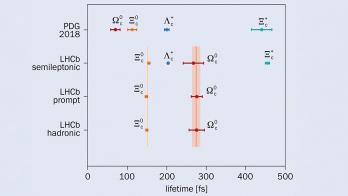
On 11 December 2018, 25 years after its inaugural meeting, the BaBar collaboration came together at the SLAC National Accelerator Laboratory in California to celebrate its many successes. David Hitlin, BaBar’s first spokesperson, described the inaugural meeting of what was then called the Detector Collaboration for the PEP-II “asymmetric” electron–positron collider, which took place at SLAC at the end of 1993. By May 1994 the collaboration had chosen the name BaBar in recognition of its primary goal to study CP violation in the neutral B-B̅ meson system. Jonathan Dorfan, PEP-II project director, recounted how PEP-II was constructed by SLAC, LBL and LLNL. Less than six years later, PEP-II and the BaBar detector were built and the first collision events were collected on 26 May 1999. Twenty-five years on, and BaBar has now chalked up more than 580 papers on CP violation and many other topics.
BaBar has now chalked up more than 580 papers on CP violation and many other topics.
The “asymmetric” descriptor of the collider refers to Pier Oddone’s concept of using unequal electron and positron beam energies – tuned to 10.58 GeV, the mass of the ϒ(4S) meson and just above the threshold for producing a pair of B mesons. This relativistic boost enabled measurements of the distance between the points where the mesons decay, which is critical for the study of CP violation. Equally critical was the entanglement of the B meson and anti-B meson produced in the ϒ(4S) decay, as it marked whether it was the B0 or B̅0 that decayed to the same CP final state by tagging the flavour of the other meson.
By October 2000 PEP-II had achieved its design luminosity of 3 × 1033 cm–2 s–1 and less than a year later BaBar published its observation of CP violation in the B0 meson system based on a sample of 32 × 106 pairs of B0-B̅0 mesons – on the same day that Belle, its competitor at Japan’s KEK laboratory, published the same observation. These results led to Makoto Kobayashi and Toshihide Maskawa sharing the 2008 Nobel Prize in Physics. The ultimate luminosity achieved by PEP-II, in 2006, was 1.2 × 1034 cm–2s–1. BaBar continued to collect data on or near the ϒ(4S) meson until 2007 and in 2008 collected large samples of ϒ(2S) and ϒ(3S) mesons before PEP-II was shut down. In total, PEP-II produced 471 × 106 B-B̅ pairs for BaBar studies – as well as a myriad of other for other investigations.
The anniversary event also celebrated technical innovations, including “trickle injection” of beam particles into PEP-II, which provided a nearly 40% increase in integrated luminosity; BaBar’s impressive particle identification, made possible by the DIRC detector; and the implementation of a computing model – spurred by PEP-II delivering significantly more than design luminosity – whereby countries provided in-kind computing support via large “Tier-A” centres. This innovation paved the way for CERN’s Worldwide LHC Computing Grid.
Notable physics results from BaBar include the first observation in 2007 of D–D̅ mixing, while in 2008 the collaboration discovered the long-sought ηb, the lowest energy particle of the bottomonium family. The team also searched for lepton-flavour violation in tau–lepton decays, publishing in 2010 what remain the most stringent limits on τ → μγ and τ → eγ branching fractions. In 2012, making it onto Physics World’s top-ten physics results of the year, the BaBar collaboration made the first direct observation of time-reversal violation by measuring the rates at which the B0 meson changes quantum states. Also published in 2012 was evidence for an excess of B̅→ D(*)τ– ν̅τ decays, which challenges lepton universality and is an important part of the current Belle II and LHCb physics programmes. Several years after data-taking ended, it was recognised that BaBar’s data could also be mined for evidence of dark-sector objects such as dark photons, leading to the publication of two significant papers in 2014 and 2017. Another highlight, published last year, is a joint BaBar–Belle paper that resolved an ambiguity concerning the quark-mixing unitarity triangle.
Although BaBar stopped collecting data in 2008, this highly collegial team of researchers continues to publish impactful results. Moreover, BaBar alumni continue to bring their experience and expertise to subsequent experiments, ranging from ATLAS, CMS and LHCb at the LHC, Belle II at SuperKEKB, and long-baseline neutrino experiments (T2K, DUNE, HyperK) to dark-matter (LZ, SCDMS) and dark-energy (LSST) experiments in particle astrophysics.








